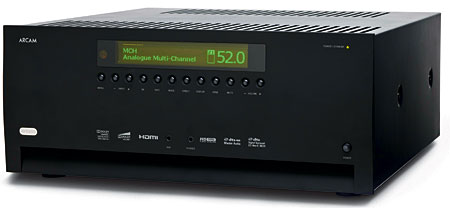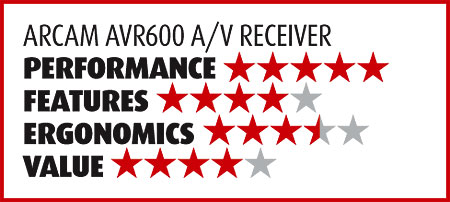Arcam AVR600 A/V Receiver Page 2
 Why Class G?
Why Class G?
Saving the item with perhaps the greatest sonic ramifications for last, this receiver uses a somewhat unusual amplifier topology. It’s not a digital amp, nor is it a Class D amp (which incidentally are not interchangeable terms for the same thing). This is a Class G amp. It uses rail switching, which shifts the signal among output transistors that operate at different voltages. That saves energy because all of the output devices don’t need to be active at the same time. Arcam calls this receiver the Bauhaus Powerhouse and rates it at 120 watts with all channels driven. It is pretty brawny, at more than 55 pounds. A week after I hoisted it a mere foot off the floor and onto my rack, I still had abdominal pains.
John Dawson, founder of Arcam, tells us: “The original aim of adopting Class G was to get more voltage swing into 8 ohms without getting too hot. In the end, we preferred absolute quality over the highest possible quantity of output, and so we opted for a more consistent current drive cap-ability into lower impedance loads while still running relatively cool for reasons of long-term reliability. The result is that the unit will drive 4 ohms continuously and is in practice stable down to loads of 2 ohms or thereabouts, even those with quite big phase shifts. The amplifier operates in a form of Class A up to about 20 watts into 8 ohms without having to have the full levels of standing current you would normally associate with Class A.”
Dawson also says, “A lot of (expensive!) care has been taken to get the very best possible thermal behavior in the output stages. This includes using rather nice American power transistors with their own temperature-sensing diodes on the silicon. We also used four-layer boards with all 2-ounce copper tracks for the power amps—something rarely if ever found in A/V receivers. This was driven by space constraints but also allowed us to optimize the layout (and thus minimize unwanted interactions) to a much better degree than would have been normal using a two- or (perish the thought) single-layer PCB design.”
Associated equipment included five Paradigm Reference Studio 20 v.4 speakers operating full range. Incidentally, the latest version of these speakers has curved enclosures that cannot be stacked when stored, which is the only reason why I don’t use them. Civilians who visit me are still bowled over by the quality of sound from my speakers. Signal sources included a Panasonic DMP-BD55 Blu-ray player, Rega Planar 25 turntable, and Shure V97xE phono cartridge. My phono preamp sat out this review since the receiver already has a phono stage.
Like Tubes but More Dynamic
Sometimes it takes me days of listening and note-taking before I decide how a receiver sounds. In this case, it took me about a minute. Although first impressions can deceive, they didn’t in this case. This receiver has loads of power and typically operated at less than half of its volume control range. Sometimes it operated at as little as a third—which is an unusual amount of gain. It had the strongest bass I’ve ever heard from a receiver. The top end held back a bit. While it wasn’t vague or gauzy, and certainly not harsh, it was sometimes reticent, depending on the source material. Midrange was noticeably warm, as though voiced by someone who regarded mellow tube sound as the gold standard. I wish my job were always this easy and pleasant.

I started with Notorious (DVD, Dolby Digital)—not the Hitchcock classic but the biopic about the late Biggie Smalls, a.k.a. the Notorious B.I.G., the musically influential and historically significant icon of East Coast rap. The opening hip-hop club scene pounded like a monster, as did all the successive rap interludes. Actors enunciated, a characteristic of good storytelling that the Arcam’s highly communicative midrange abetted. Dynamics in this tumultuous film couldn’t have been better.
Meet Dave (Blu-ray), in DTS-HD Master Audio, blends orches-tra, dialogue, effects, and other elements in a predictable way, and the Arcam slightly sweetened these elements. All of the sonic elements were secondary to Eddie Murphy’s talent for physical comedy and his even more considerable talent for mugging and other facial contortions.
The Messenger (Blu-ray), in Dolby TrueHD, features an orchestral score that pulls out all the stops. It includes a sad scene with an oboe floating over a sorrowing orchestra, a coronation serenaded by a chorus, and battle scenes that are doomily sprinkled with actual passages from Carl Orff’s Carmina Burana (the normal practice of soundtrack composers is just to steal it). As a movie with wide dynamic range—though by no means the most extreme one I’ve ever heard—it became the lab rat for Dolby Volume. I watched it through once, au naturel, then replayed segments with the Dolby Volume Cinema mode switched in and out.
The difference was not subtle. Dolby Volume not only kept me aware of every word to escape an actor’s lips, it also sharpened background sounds to a level probably only experienced by household pets. I got a better sense of layering. The impact of battle scenes was strongly blunted, and I liked that because it made the fighting more dreamlike and less fatiguing. The only caveat about Dolby Volume (at its default leveling setting of 9) is that it’s designed for low-level listening. At higher volume, a whispered conversation could be almost deafening, and the heightening of background sounds was distracting.
The bottom line is, you wouldn’t want the full Dolby Volume treatment if you’re listening at (or even near) the reference level. But if you’re listening well below it, it’ll solve a multitude of problems and keep your hand from groping for the remote. This isn’t an either/or choice—I used the default setting of 9 for my testing, but you can also adjust Dolby Volume’s leveling control for listening at moderate volumes below the reference level.
More Science Experiments
During my all-vinyl music sessions, I continued to meditate on Dolby Volume. I used the Music mode this time, but I also played with the usual Dolby Pro Logic II Music mode versus stereo dichotomy, as well as the pure analog Stereo Direct mode.
The Grateful Dead’s untitled live double-LP set—often referred to as Skull and Roses, after its jacket art—thrived in any mode. In Stereo Direct mode, the center image was so solid that I could barely alter it even with significant side-to-side movements. There was no need to use DPLII just for the center image. But the stereo-to-surround adaptation did make the speakers less localizable—they virtually disappeared. However, in stereo, extreme left and right objects were still strongly tied to the speakers. The richness of vocal and spatial reproduction made my $100 cartridge sound like a more costly one—the phono stage is pretty good. Dolby Volume did not improve on an already ideal situation. In fact, when it was on, I often resented its presence because it seemed to undermine decisions made by the band (like the decision to play quietly) or by its mixers (like fading down a track).
I moved on to another untitled live album, this time by German pianist Joachim Kühn and Dutch guitarist Jan Akkerman, which is sometimes referred to as The Kiel/Stuttgart Concerts. It consists of two long workouts of the same piece, with Kühn channeling Keith Jarrett throughout and Akkerman switching from a Roland guitar synthesizer on side one to a Gibson double-neck guitar on side two. The contrast between the beautifully recorded piano and the inherently harsh guitar synth was striking, as was the switch from that to the more luminous traditional electric guitar tone. Arcam made the most of this rich set of tonal and dynamic possibilities. DPLII brought the piano a few feet forward, but the proximity seemed unnatural, so I settled on the Stereo Direct mode and marveled at the interplay between pianist and guitarist.
Bernard Herrmann’s score for Alfred Hitchcock’s Vertigo is the only one he didn’t conduct—Muir Mathieson did the honors with the London Sinfonia. It would be hard to overstate the sheer beauty and richness of the strings, the tang of the brass, and the soph-isticated weave of textures that Herrmann lavishes on this tale of obsessive love. With material of this caliber, Dolby Volume generally didn’t help. Although it uncovered some interesting textures among the reeds, it made the swooningly euphonic string and brass textures sound hard and glassy. Perspective was skewed from moment to moment, as though I were running from the back of the hall, to the front, and back again. Tape hiss and groove noise, of which I had been completely unaware without processing, became apparent and unwelcome. This music worked best in Stereo Direct mode or the unenhanced DPLII mode.
The Arcam AVR600 is one of the best receivers I’ve heard from any brand. It’s built like a tank, it’s unfailingly musical, and it just plain feels right. It is also one of the few receivers I’ve reviewed that could probably dominate a large room with speakers of average sensitivity—I say probably only because I don’t have access to a large room. Dolby Volume is a plus, although it’s largely for low-level movie and TV listening. The remote and front panel are decidedly austere, but apart from that, this product makes a strong case for its price tag. It proves that high end home theater and audiophile receiver are not contradictory terms.

- Log in or register to post comments






























































